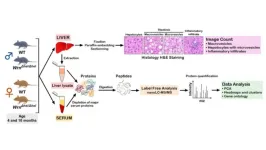(Press-News.org)
New Haven, Conn. — A new scientific model is giving researchers an unprecedented, global look at the activities of clams, worms, and other invertebrate animals that burrow at the bottom of the ocean.
And what they find may offer new insights into how these mud-churning species affect ocean chemistry, carbon sequestration, and the ability of marine life to thrive globally.
Scientists have long debated the role of “bioturbation” — the excavation and stirring up of seafloor sediments caused by these species. Part of the challenge has come from trying to understand how the interactions between these animals and their surroundings influence bioturbation patterns and marine ecosystems worldwide.
New research published in the journal Current Biology offers a wealth of new data that may help answer these questions.
“Through our analysis, we discovered that not just one, but multiple environmental factors jointly influence seafloor bioturbation and the ecosystem services these animals provide,” said co-author Lidya Tarhan, assistant professor of Earth and planetary sciences in Yale’s Faculty of Arts and Sciences. “This includes factors that directly impact food supply, underlying the complex relationships that sustain marine life, both today and in Earth’s past.”
For the study, the researchers used global seafloor and seawater data and machine learning techniques to map out the ocean environments where marine invertebrates live and discern what factors shape environmental conditions globally.
In previous studies, the research community had sought out a single, controlling factor that would explain variations in bioturbation observations. By contrast, Tarhan and her colleagues found that bioturbation is shaped by a combination of factors, acting in concert.
The most important global factors, they discovered, are seawater depth, nutrient levels in the water, and sediment composition.
“Knowing how bioturbation links to other aspects of the environment means that we are now better equipped to predict how these systems might change in response to climate change,” said lead author Shuang Zhang, a former Ph.D. student and postdoctoral researcher at Yale who is now an assistant professor in the Department of Oceanography at Texas A&M University.
The new study also yielded insights into the variety of ways in which animals excavate the seafloor — and how seemingly similar animal behaviors can, on a global scale, be shaped by entirely different sets of environmental factors.
For instance, the researchers found that environmental factors driving deep sea bioturbation can differ significantly from those factors influencing seafloor communities in coastal and shallow ocean waters. In deep ocean waters, seawater nutrient levels remain impactful, but water depth and sediment type appear to be less important. Instead, the velocity of surface ocean currents and the enrichment of seafloor sediments by organic matter play key roles in shaping deep-sea bioturbation.
These findings have important ramifications for ocean conservation and for developing strategies to mitigate habitat deterioration and protect marine biodiversity, the researchers say.
“Our analysis suggests that the present global network of marine protected areas does not sufficiently protect important seafloor processes like bioturbation, indicating that protection measures need to be better catered to promote ecosystem health,” Tarhan said.
Added co-author Martin Solan, a professor of marine ecology at the University of Southampton: “We have known for some time that ocean sediments are extremely diverse and play a fundamental role in mediating the health of the ocean, but only now do we have insights about where, and by how much, these communities contribute.”
The research was funded with support from the Natural Environment Research Council and Yale University.
END
An article published in the journal Insects determines with precision the dispersal range of a type of wasp that neutralizes the Brown stink bug, Euschistus heros, a major soybean pest in Brazil and highly resistant to chemical insecticides. The solution discussed by the authors is Telenomus podisi, a parasitoid micro wasp first described by American entomologist William Harris Ashmead in 1893.
Parasitoids are small insects whose immature stages develop either within or attached to the outside of other insects. They ...
Rutgers University–New Brunswick researchers conducting a study at a high-traffic intersection in a Jersey Shore town have found that the installation of a bike lane along the road approaching the convergence reduced driving speeds.
As many traffic analyses have identified speeding as a contributing factor in a majority of crashes, inducing such a “traffic calming” effect with a bike lane could enhance road safety and decrease the risk and severity of crashes, the researchers said. The research was published in The Journal of Urban Mobility.
“We are giving you more evidence that bike lanes save lives,” said Hannah Younes, a lead author of the study and a postdoctoral ...
“Proteomics analysis at different ages allows us to follow the progressive biological alterations (including histological fat accumulation) in the liver according to age and/or the Wrn genotype.”
BUFFALO, NY- June 3, 2024 – A new research paper was published on the cover of Aging (listed by MEDLINE/PubMed as "Aging (Albany NY)" and "Aging-US" by Web of Science) Volume 16, Issue 10, entitled, “Integrated liver and serum proteomics uncover sexual dimorphism and alteration of several immune response proteins in an aging Werner syndrome mouse model.”
Werner syndrome (WS) is a ...
CAMBRIDGE, MA – Let’s say you want to train a robot so it understands how to use tools and can then quickly learn to make repairs around your house with a hammer, wrench, and screwdriver. To do that, you would need an enormous amount of data demonstrating tool use.
Existing robotic datasets vary widely in modality — some include color images while others are composed of tactile imprints, for instance. Data could also be collected in different domains, like simulation or human demos. And each dataset ...
May 23, 2024
Obeldesivir (GS-5245), a novel investigational small molecule oral antiviral, represents a new tool in the ongoing effort to prepare for future pandemics.
Several researchers at the University of North Carolina at Chapel Hill’s Gillings School of Global Public Health are co-authors of a new study published online May 22 by the journal Science Translational Medicine.
The study shares findings from an academic-corporate partnership between biopharmaceutical company Gilead Sciences and the Sheahan ...
Key takeaways
The movement of carbon between the atmosphere, oceans and continents — or carbon cycle — regulates Earth’s climate, with the ocean playing a major role in carbon sequestration.
A new study finds that the shape and depth of the ocean floor explain up to 50% of the changes in depth at which carbon has been sequestered there over the past 80 million years.
While these changes have been previously attributed to other causes, the new finding could inform ongoing efforts to combat climate change through marine carbon sequestration.
The movement of carbon between the atmosphere, oceans and continents — the carbon ...
FOR IMMEDIATE RELEASE
Monday, June 3, 2024
Contact:
Jillian McKoy, jpmckoy@bu.edu
Michael Saunders, msaunder@bu.edu
##
Airplane Noise Exposure May Increase Risk of Chronic Disease
A new study found that people who were exposed to higher levels of noise from aircraft were more likely to have a higher body mass index, an indicator for obesity that can lead to stroke or hypertension. The findings highlight how the environment—and environmental injustices—can shape health outcomes.
Research has shown that noise from airplanes and helicopters flying overhead are far more bothersome to people than noise from other modes of transportation, ...
Coworker and employer support are strong predictors of nurses planning to stay in their jobs, while symptoms of depression are linked to nurses planning to leave, according to a study conducted at the height of the COVID-19 pandemic by researchers at NYU Rory Meyers College of Nursing.
The research—published in the Online Journal of Issues in Nursing, a journal of the American Nurses Association—examines both pandemic-related factors and the overall work environment for nurses and can help organizational ...
Gaps persist in hiring enough U.S. public health workers and health departments continue to face challenges in recruiting new employees, according to a new study by Columbia University Mailman School of Public Health and Indiana University. Insufficient funding, a shortage of people with public health training, and a lack of visibility for public careers, in addition to lengthy hiring processes, are cited as barriers contributing to an absence of progress for achieving a satisfactory level of workers. The results ...
Redox Science Meets Medicine at the 26th International Conference on Redox Medicine 2024 this June in Paris
The 26th International Conference on Redox Medicine 2024 will take place this month, on June 27-28 at Fondation Biermans-Lapôtre in Paris, France.
With 41+ communications and participants from 20 different countries, the conference promises a diverse exchange of knowledge and ideas.
The sessions of the conference are organized around key topics, with each speaker addressing a specific ...


